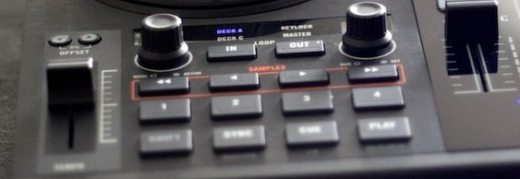
While we don’t cover too much in the way of specialty gadgets here at TNW, the success of a review that I did on another Native Instruments system a few months ago leads me to believe that there are more than a few of you who quite like to read about this sort of thing, so I’ve decided to branch out a bit and include reviews on this type of equipment when I can.
With that said, if you’re reading this then I’m going to assume that you’re familiar with DJ terminology so I’m not going to take up extra words explaining things. If you’re not familiar but this still interests you, there are loads of tutorials across the Internet and YouTube is full of them. Also, since this is a review of the hardware, I’m not going to go too in depth with the features of Traktor Pro, except where necessary for the hardware tie-in. Though the S4 ships with a special version of Traktor called Traktor Pro S4, Traktor Pro is a free update and it’s what you’re going to want to use.
If you had asked me 5 years ago to write anything about a MIDI controller that would take the place of a traditional turntables and mixer DJ setup, I’d have laughed at you. Being a die-hard vinyl purist, it’s been a long road for me to accept that MIDI controllers can be not only viable but actually preferable in some cases.
When I first laid eyes on to the Traktor Kontrol S4 from German-born Native Instruments, I was impressed. It is a fully-featured 4-deck mixer, plus 2 MIDI controllers all wrapped into a single system. It’s relatively portable, has a load of features that you’re not likely to find on many other controllers and makes much of what I’ve come to love about the Traktor Pro system even better to use.
Overview
The S4 is laid out in 3 sections. From left to right you have a play/control deck, a 4-channel mixer, then another play/control deck. Each of the play decks has buttons to fire off 4 sample players, plus 4 hot cues. There’s a loop section with knobs to control loop location and size, as well as setting loops and making them active. Of course, you can still do the “old fashioned” way of pressing an In and Out button to set your loops, but Traktor does an amazing job of picking them out and setting them automatically.
4 hot cues can be assigned to each track, enabling you to jump to a specific section and immediately start playing from there. As is common with Traktor, if you’re playing anything other than straight 4/4 beat music, you’ll probably have to adjust your initial track position because it tends to put that first point at the location of the first sound, which isn’t always the first beat of a track.

A jog wheel holds a combined function of allowing you to speed up or slow down a track, as well as a turntable-esque “scratch” function that is enabled by pressing down slightly on the top while turning. Not being a turntablist-style DJ myself, I can’t speak as to how well this would work for scratching, but I’ve seen it done by others to admirable results.
The top of each play section holds 4 knobs and a couple of buttons for effects. Essentially it allows you to assign up to 6 effects to any track, adjusting parameters of them on the fly. You can assign 3 from each side, and a button on the channel gain section allows you to assign the effects section to whichever side you would like.
Likely the most important and biggest “game-changer” section of the S4 is the sample deck area. With these 4 buttons you can fire off samples on the fly and they’re going to automatically be beatmatched for you. Alternately, a double-tap of any of them will load a specific 8-bar section of the currently playing track, making them great for instant fills while you work on something else.
Build Quality
Every Native Instruments product that I’ve ever used has been built to the highest of standards and the S4 is no exception to that rule. It’s heavy enough to be stable, but not so heavy that you’d be prevented from carrying it to a gig. The combination of (what seems to be) aluminum and plexiglass on the top panel add a contrasting finish that looks great even if the shiny middle section does tend to attract fingerprints. The rest of the unit is finished in a matte plastic that still manages to both feel solid and look classy.
My sole complaint about the choice of finishes takes us back to the top panel. Traditionally, top panels of mixers are made from a single, solid piece of metal or plastic. While this might not end up looking as “pretty” as the S4’s combination, it tends to keep the grime and dust from having anyplace to settle. On the S4, with its numerous plate joints, you can tend to get a load of gunk falling into them because, facing facts, dance clubs can be dirty places. I’d love to see an option that takes this to a single, solid piece of plexi, instead of the joined pieces of metal and plastic.

The buttons and knobs of the S4 are fantastic. I have absolutely zero complaints about them. That’s saying quite a lot, considering that I’m typically very critical of knob spacing in the EQ and effects section on most DJ equipment. Even with my sausage-sized fingers, I never feel cramped when using the S4.
Input and output placement on the back panel of the S4 is laid out well and clear in its use. No complaints here, other than a naggingly-missing pair of outputs which I will address shortly.

Front panel knobs, consisting of cue mix, cue volume and mic volume, are a locking style which will require you to press them in to get them to pop out. Again, the knob quality is top notch and I have zero complaints. Unfortunately, I can’t say the same for the headphone output.

On my demo unit S4, the headphone jack has a “dead spot”. That is to say that when I plug in my headphones I have to twist them in the jack just a bit in order to get full-range sound. If I don’t, it sounds like a speaker that’s only getting a partial signal. While I’m sure that this is a one-off defect of my demo unit, it’s still frustrating from something that retails for nearly $1,000.
Coming next, we’ll talk about what’s right and what’s wrong, then let you know if you want to buy it. On mobile? Click here.
What’s Done Right?
Native Instruments is renowned for having top-quality audio. The S4 holds true to that reputation, providing a 4-channel sound card that is second to only a very few other products on the market. At this price range, you’re not going to find anything that will give you the sound quality that NI’s internal card does. It plays just about anything you can throw at it, including MP3, WAV, AIFF, Audio-CD, FLAC, Ogg Vorbis, non-DRM WMA and non-DRM AAC files with stunning clarity.
Again, build quality is superb (with the one headphone-based caveat) and I’ve not yet used a full controller that felt this solid. Even with a wealth of plastic, it feels like the S4 can stand up to the abuse of being loaded into clubs. Overall, the feel of the unit is just…right, for lack of a better term. The transition from using turntables to using the S4 feels natural and there’s a reason behind that.
With the release of Traktor Pro 2 and the most recent software update to the S4, Native Instruments made the C and D channels of the S4 even more useful. Now, instead of being the volume controls for your sample or 3rd and 4th decks, they can actually be used to control volume on physical turntables or CD decks that you’re also using with Traktor Pro, essentially turning it into Traktor Scratch, the vinyl-controlled version of this same software.
I love that you’re given the option to run Deck C as a throughput deck, allowing you to run a 3-input option. There’s even a grounding screw on the back of the unit, showing that the turntable-control option wasn’t an afterthought for NI, but rather was designed from the start. I’m glad to see that there are outputs in both balanced and unbalanced which is vitally important for some systems.
In short, the physical features of the S4 are all done very well. I have only a few minor complaints when it comes to the design of the system, but we’ll talk about them next.
What’s Done Wrong?
To be fully honest? Next to nothing. The Kontrol S4 has been the first controller I’ve used that has left me feeling like I could walk away from a traditional DJ setup in favor of a MIDI-based one. Traktor itself is a beautifully-done piece of software which serves only to solidify that fact and I’ve had an absolute blast playing with the features.
You’ll notice, however, that I said “next” to nothing. That leaves me an open door to talk about my single nagging problem with the S4. Unfortunately, it’s enough of a nagging problem for my particular way of using things that it keeps the unit from being my answer to prayers.
There’s no booth output. None. Even though there are two sets of outputs on the back of the unit, there’s no way to control them separately from one another. You have only a single master volume control at the top of the unit. Now, if all you’re doing is playing with the S4 at home, that’s probably just fine for you. But let’s talk about other, more likely scenarios for someone who will buy a $1,000 controller:
Club Gigs: Walk in, run a line from the output of the S4 to the input of the club’s mixer and you’re set. But, if you want to control the volume in the booth, you’re going to have to do that from the club’s mixer.
Club Installation: No. Just no. If I ever walk into a club that doesn’t have the ability for me to control the booth output volume without adjusting the volume of the house, I’m going to laugh all the way back out to my car and go home.
Internet DJ: You’re playing, you need more or less volume from your monitors. You’re going to have to have a second mixer hooked up that controls your monitors. Still not a good choice.
So really, unless you’re traveling with the S4, using it in clubs that have room for you to set it up and then use their own mixer for monitor control, it’s an absolutely huge pain in the tail. It’s beyond me how a company that designed a device that thought of so many things ahead of time managed to completely forget that the ability to have external monitoring of the output is crucial.
Should You Buy It?
If I could leave off the section about the monitor, then my answer would be a resounding yes. I would have absolutely no qualms in recommending the S4 to anyone who wants a fully-featured hardware controller for Traktor. But I can’t do that. I have to take the monitors into consideration.
That leaves us looking at how you’ll use it, and whether it’s going to be feasible for you to use it with the restrictions that the single-output system has. If you can deal with it, then it’s still an amazing piece of hardware. If you can’t? Well, then the answer is simple – Don’t buy it.
Assuming that you can, however, there’s hardly anything on the market that compares to the Kontrol S4. It’s portable, there are a few different cases already on the market for it and it’s built like a tank. It sounds incredible and it gives you hands-off-computer access to almost anything you’d want to do inside of Traktor. That’s a huge amount of benefit for a controller that’s priced at a premium.
In short, it comes down to how you’ll use it. The Traktor Kontrol S4 is a beautiful piece of hardware, both in form and function, but that no-monitor flaw might be enough to kill its chances of coming into your studio.
Get the TNW newsletter
Get the most important tech news in your inbox each week.





